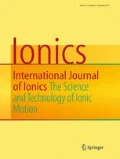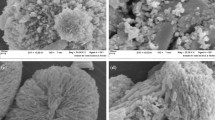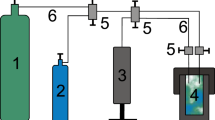Abstract
Agglomerates of tungsten trioxide in the range of 90 nm to 1 μm are prepared by the acid precipitation method and characterized by XRD as well as scanning electron microscopy. The product when coated with platinum showed pseudocapacitance when in contact with acidic electrolyte in the potential range of 0.1 to −0.25 V/SCE. Capacitance in the range of 0.014 to 0.039 F cm−2 exhibiting moderate potential dependencies measured through both chronopotentiometry and impedance spectroscopy is presumed to be due to the insertion/de-insertion of protons into the lattice of tungsten trioxide. Equivalent circuit consisting of parallel simulators of mass transfer and capacitor charging (insertion/de-insertion) fully compatible with the impedance measurements has been proposed and circuit parameters have been derived.






Similar content being viewed by others
References
Conway BE (1999) Electrochemical supercapacitors: scientific fundamentals and technological applications. Kluwer Academic/Plenum, New York
Jow TR, Zheng J (1998) Electrochemical capacitors using hydrous ruthenium oxide and hydrogen inserted ruthenium oxide. J Electrochem Soc 145:49
Zolfaghari A, Ataherian A, Ghaemi M, Gholami A (2007) Capacitive behavior of nanostructured MnO2 prepared by sonochemistry method. Electrochim Acta 52:2806
Ghaemi M, Ataherian F, Zolfaghari A, Jafari SM (2008) Charge storage mechanism of sonochemically prepared MnO2 as supercapacitor electrode: effects of physisorbed water and proton conduction. Electrochim Acta 53:4607
Subramanian V, Zhu H, Vajtai R, Ajayan PM, Wei B (2005) Hydrothermal synthesis and pseudocapacitance properties of MnO2 nanostructures. J Phys Chem B 109:20207
Lin C, Ritter JA, Popov BN (1998) Characterization of sol–gel-derived cobalt oxide xerogels as electrochemical capacitors. J Electrochem Soc 145:4097
Liu TC, Pell WG, Conway BE (1999) Stages in the development of thick cobalt oxide films exhibiting reversible redox behavior and pseudocapacitance. Electrochim Acta 44:2829
Nam KW, Kim KB (2002) A study of the preparation of NiO x electrode via electrochemical route for supercapacitor applications and their charge storage mechanism. J Electrochem Soc 149:A346
Xu MW, Bao SJ, Li HL (2007) Synthesis and characterization of mesoporous nickel oxide for electrochemical capacitor. J Solid State Electrochem 11:372
Sugimoto W, Ohnuma T, Murakami Y, Takasu Y (2001) Molybdenum oxide/carbon composite electrodes as electrochemical supercapacitors. Electrochem Solid State Lett 4:A145
Murugan AV, Viswanath AK (2006) Highly efficient organic-inorganic poly(3,4-ethylenedioxythiophene)-molybdenum trioxide nanocomposite electrodes for electrochemical supercapacitor. J App Phys 100:074319
Farsi H, Gobal F, Raissi H, Moghiminia S (2010) On the pseudocapacitive behavior of nanostructured molybdenum oxide. J Solid State Electrochem 14:643
Farsi H, Gobal F, Raissi H, Moghiminia S (2010) The pH effects on the capacitive behavior of nanostructured molybdenum oxide. J Solid State Electrochem 14:681
Huang CC, Xing W, Zhuo SP (2009) Capacitive performances of amorphous tungsten oxide prepared by microwave irradiation. Scripta Mater 61:985
Ganesan R, Perelshtein I, Gedanken A (2008) Biotemplated synthesis of single-crystalline W18O49@C core–shell nanorod and its capacitance properties. J Phys Chem C 112:1913
Chang KH, Hu CC, Huang CM, Liu YL, Chang CI (2011) Microwave-assisted hydrothermal synthesis of crystalline WO3–WO3·0.5H2O mixtures for pseudocapacitors of the asymmetric type. J Power Sources 196:2387
Zou BX, Liang Y, Liu XX, Diamond D, Lau KT (2011) Electrodeposition and pseudocapacitive properties of tungsten oxide/polyaniline composite. J Power Sources 196:4842
Ren XB, Lu HY, Lin HB, Liu YN, Xing Y (2010) Preparation and characterization of the Ti/IrO2/WO3 as supercapacitor electrode materials. Russ J Electrochem 46:77
Khyzhun OY, Solonin YM (2000) Electronic structure of the monoclinic and hexagonal trioxides of tungsten and hexagonal hydrogen tungsten bronze H 0.24 WO 3 . Powder Metall Met Ceram 39:287
Hechavarría L, Hu L, Miranda M, Nicho ME (2009) Electrochromic responses of low-temperature-annealed tungsten oxide thin films in contact with a liquid and a polymeric gel electrolyte. J Solid State Electrochem 13:687
Santato C, Odziemkowski M, Ulmann M, Augustynski J (2001) Crystallographically oriented mesoporous WO3 films: synthesis, characterization, and applications. J Am Chem Soc 123:10639
Santato C, Ulmann M, Augustynski J (2001) Photoelectrochemical properties of nanostructured tungsten trioxide films. J Phys Chem B 105:936
Kikuchi E, Iida K, Fujishima A (1993) Photochromism and photoelectrochemistry of amorphous and polycrystalline WO3 films. J Electroanal Chem 351:105
He T, Ma Y, Cao Y, Hu X, Liu H, Zhang G, Yang W, Yao J (2002) Photochromism of WO3 colloids combined with TiO2 nanoparticles. J Phys Chem B 106:12670
Cantalini C, Wlodorski W, Li Y, Passacantando M, Santacci S, Comini E, Faglia G, Sberveglieri G (2000) Investigation on the O3 sensitivity properties of WO3 thin films prepared by sol–gel, thermal evaporation and r.f. sputtering techniques. Sens Actuators B 64:182
Kawasaki H, Namba J, Iwatsuji K, Suda Y, Wada K, Ebihara K, Ohshima T (2002) NO x gas sensing properties of tungsten oxide thin films synthesized by pulsed laser deposition method. Appl Surf Sci 197:547
Hong SJ, Jun H, Borse PH, Lee JS (2009) Size effects of WO3 nanocrystals for photooxidation of water in particulate suspension and photoelectrochemical film systems. J Am Hydrogen Energy 34:3234
Yang LX, Bock C, Macdougall B, Park J (2004) The role of the WO x ad-component to Pt and PtRu catalysts in the electrochemical CH3OH oxidation reaction. J Appl Electrochem 34:427
Papaefthimiou S, Leftheriotis G, Yianoulis P (2001) Advanced electrochromic devices based on WO3 thin films. Electrochim Acta 46:2145
Najdoski MZ, Todorovski T (2007) A simple method for chemical bath deposition of electrochromic tungsten oxide films. Mater Chem Phys 104:483
Patra A, Auddy K, Ganguli D, Livage J, Biswas PK (2004) Sol–gel electrochromic WO3 coatings on glass. J Mater Lett 58:1059
Khatko V, Vallejos S, Colderer J, Llobet E, Vilanova X, Correig X (2007) Gas sensing properties of WO3 thin films deposited by rf sputtering. Sens Actuators B 126:400
Ponzoni A, Comini E, Ferroni M, Sherveglieri G (2005) Nanostructured WO3 deposited by modified thermal evaporation for gas-sensing applications. Thin Solid Films 490:81–85
Krasnov YS, Kolbasov GY, Zaichenko VN (2006) Kinetics of coloration of electrochromic tungsten oxide films produced by cathodic electrodeposition. J Appl Chem 79:250
Yang B, Li H, Blackford M, Luca V (2006) Novel low density mesoporous WO3 films prepared by electrodeposition. J Appl Phys 6:436
Yu Z, Jia X, Du J, Zhang J (2000) Electrochromic WO3 films prepared by a new electrodeposition method. Sol Energy Mater Sol Cell 64:55
Supothina S, Seeharaj P, Yoriya S, Sriyudthsak M (2007) Synthesis of tungsten oxide nanoparticles by acid precipitation method. J Ceramics Inter 33:931
Schmidt TJ, Noeske M, Gasteiger HA, Behm RJ, Britz P, Bönnemann H (1998) PtRu alloy colloids as precursors for fuel cell catalysts. J Electrochem Soc 145:925
Schmidt TJ, Gasteiger HA, Stäb GD, Urban PM, Kolb DM, Behm RJ (1998) Characterization of high-surface-area electrocatalysts using a rotating disk electrode configuration. J Electrochem Soc 145:2354
Sugimoto W, Kizaki T, Yokoshima K, Murakami Y, Takasu Y (2004) Evaluation of the pseudocapacitance in RuO2 with a RuO2/GC thin film electrode. Electrochim Acta 49:313
Sugimoto W, Iwata H, Yokoshima K, Murakami Y, Takasu Y (2005) Proton and electron conductivity in hydrous ruthenium oxides evaluated by electrochemical impedance spectroscopy: the origin of large capacitance. J Phys Chem B 109:7330
Gupta V, Gupta S, Miura N (2008) Potentiostatically deposited nanostructured Co x Ni1−x layered double hydroxides as electrode materials for redox-supercapacitors. J Power Sources 175:680
Luo JM, Gao B, Zhang XG (2008) High capacitive performance of nanostructured Mn–Ni–Co oxide composites for supercapacitor. Mater Res Bulletin 43:1119
Farsi H, Gobal F (2007) Theoretical analysis of the performance of a model supercapacitor consisting of metal oxide nano-particles, (2007) J Solid State. Electrochem 11:1085
Farsi H, Gobal F (2009) A mathematical model of nanoparticulate mixed oxide pseudocapacitors; part I: model description and particle size effects. J Solid State Electrochem 13:433
Farsi H, Gobal F (2011) A mathematical model of nanoparticulate mixed oxide pseudocapacitors; part II: the effects of intrinsic factors. J Solid State Electrochem 15:115
Lin C, Ritter JA, Popov BN, White RE (1999) A mathematical model of an electrochemical capacitor with double-layer and faradaic processes. J Electrochem Soc 146:3168
Pico F, Ibanez J, Centeno TA, Pecharroman C, Rojas RM, Amarilla JM, Rojo JM (2006) RuO2·xH2O/NiO composites as electrodes for electrochemical capacitors: effect of the RuO2 content and the thermal treatment on the specific capacitance. Electrochim Acta 51:4693
Pajkossy T (1994) Impedance of rough capacitive electrodes Impedance of rough capacitive electrodes. J Electroanal Chem 364:111
Author information
Authors and Affiliations
Corresponding author
Rights and permissions
About this article
Cite this article
Farsi, H., Gobal, F. & Barzgari, Z. A study of hydrated nanostructured tungsten trioxide as an electroactive material for pseudocapacitors. Ionics 19, 287–294 (2013). https://doi.org/10.1007/s11581-012-0726-8
Received:
Revised:
Accepted:
Published:
Issue Date:
DOI: https://doi.org/10.1007/s11581-012-0726-8




